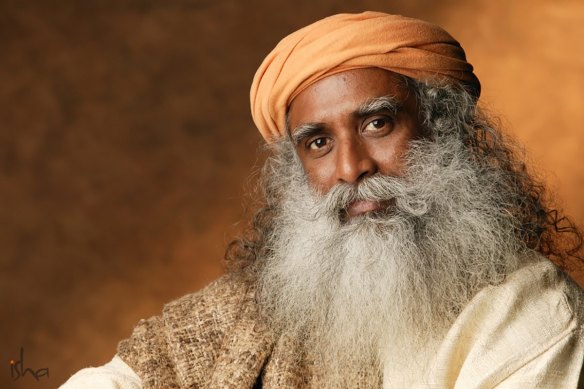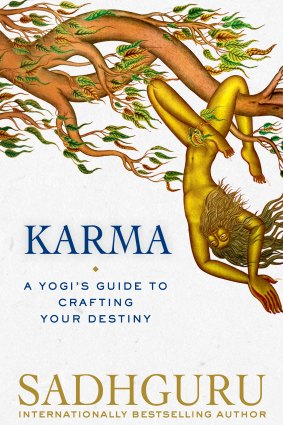This was published 3 years ago
He’s among the biggest celebrity gurus. And he wants to ‘craft your destiny’
By Sarah Berry
Gurus make me nervous. For many of us, instead of being leaders who can take us from darkness into light, they have become synonymous with corruption.
Gurus like Bikram, Sogyal Rinpoche, Bhagwan Shree Rajneesh (Osho) and Pattabhi Jois, are just a few recent examples of absolute power corrupting absolutely, even if you are enlightened.

Sadhguru: enlightened but still human.
So I was sceptical when Insta celeb-cum-guru Jaggi Vasudev AKA Sadhguru’s new book Karma landed on my desk.
But, Sadhguru, who is a motorbike-riding, Akubra-wearing, sunglass-sporting 63-year-old dude, has not only grabbed the attention of 5.2 million followers on Instagram but that of entrepreneur Tony Robbins, self-help guru Deepak Chopra and football star Tom Brady.
Robbins called the book a “must-read”, Chopra said it was “invaluable” and Brady gushed that it will “put you back in charge of your own life”.
I was intrigued. What is it about this guru that has made him so revered in the West and what does he have to say about karma, an Eastern concept that has captured the imagination of Westerners so fully that is has become part of our lexicon?
Lisa Allwell, from Yoga Australia, says that in a world where we’re more digitally connected than ever but often disconnected in real life, gurus like Sadhguru are gaining larger followings. This is because they “tap into this deep wisdom” that is passed down over millennia from teacher to teacher.
Dr Sat Bir Singh Khalsa, an assistant professor of medicine at Harvard Medical School, adds that surpassing the limits of ordinary human experience through transcendence requires a teacher.
“It’s one of the most difficult things to achieve as a human being,” he says. “So the idea of having a master becomes critically important… because they have achieved this state and they can guide you.”
When I spoke with Sadhguru he was in a camper van in El Paso, Texas, trucking around the United States on his book tour. I was instantly relieved. This was a long way from Osho, the “Rolls Royce guru” or Bikram with his fleet of Bentleys.
The humility of it made me excuse moments where the book goes beyond the limitations of my ordinary Western brain, like when he writes about sitting in a cave and perceiving the energy of a dead monk whose left leg was amputated nineteen hundred years earlier.
So, I suspended my disbelief and listened as he explained that karma is often misunderstood, especially in the Western world.
For example, we often talk about good karma and bad karma, as if there’s someone sitting on their throne in the sky pointing their finger at each of the 7.8 billion of us and doling out rewards or punishments for our thoughts and actions.
“People dumb it down to a simple reward and punishment… But karma is neither good nor bad,” Sadhguru says. “Karma is the residual impressions of all the actions we perform, physically, mentally, emotionally and energetically.”
From the moment we are born till this moment, he explains, all that we have seen, all that we have heard, every thought or emotion we have experienced and action we have performed or not performed – inaction matters too – has a consequence on the person that we have become.
The person that we are is also the result of our connection to one another, to the world around us and to our history as humans.
“If you ate what a parrot eats for the next 10 years, would you become a parrot? The evolutionary memory will make sure you stay a human being no matter what crazy thing you do,” he says. “Similarly… my physical structure is my genetic memory. You might have forgotten what your great, great, great grandmother looked like but her nose might be sitting on your face. Your body remembers.”
From the perspective of karma, this means that the outcomes in our lives are the consequence of our own behaviours, the behaviours of those around us and of those who have come before us. Despite this, we can learn to control one significant aspect of our karma from this point onwards.
“What the world throws at us is not always our choice, what we make of it is 100 per cent our choice... So this is the karma.

Karma by Sadhguru
“The quality of our life is not determined by what we have…[it is] determined by how we experience it… This choice every human being has at every moment of their life.”
His book aims to help us mortals choose a more joyful inner landscape regardless of our circumstance. He remains joyful despite 15 to 20 people he knows “very well” dying each day as a result of the pandemic ravaging India.
“If you want to become part of the solution, you don’t succumb to the misery… do you want to infect the world with your misery or with your joy?”
Simplistic as this may seem – and he acknowledges he hasn’t always been blissful, but spent many years under a “huge black cloud” of anger at all the injustice in the world – intention matters and the concept of karma captures this, according to Sadhguru.
Dr Khalsa, a researcher in mind-body medicine, agrees.
“We don’t have a term in the West for that,” Khalsa says. “If you drive a Hummer you’re polluting the atmosphere. Ultimately that’s going to come back and hurt you or your ancestors. It happens on global levels and it happens on personal levels.”
He adds: “It’s become part of parlance in the West. I think the West has adopted a number of constructs from other cultures which are now part of Western dialogue.”
The term guru is another one of these – somebody is a fashion guru, a beauty guru or a guru of the stockmarket.
The Indian term originally referred to someone who is a spiritual teacher or a master, but Khalsa points out anyone can call themselves a guru.
“There’s no academy, there’s no registry, there’s no government agency that determines who is a guru. I’ve seen people who suddenly decide that they want to call themselves a guru… and I’m saying ‘Hey, wait a minute?’”
Allwell says there are a lot of “false gurus” out there.
“There are also gurus who started out from a pure place and as they become more powerful things change,” she adds, suggesting “choose your guru wisely”.
But, she believes Sadhguru is “the real deal”, a sentiment echoed by Khalsa who says he is considered by many as “bonafide”.
Sadhguru insists he is not part of the “guru club”: “Misuse and corruption are in every industry – there are bad police, bad journalists, bad politicians, there are unfortunately bad gurus too.”
An action taken 24 years ago however has had lasting karmic consequences, complicating the reputation of this guru too.
In 1997, Sadhguru was accused by his father-in-law of murdering his 33-year-old wife Vijaykumari, mother of his then-7-year-old daughter. The accusation came after Vijaykumari’s body was cremated before her father arrived to say goodbye. To complicate matters, Sadhguru said her death was the result of mahasamadhi during meditation.
“There’s no academy, there’s no registry, there’s no government agency that determines who is a guru. I’ve seen people who suddenly decide that they want to call themselves a guru… and I’m saying ‘Hey, wait a minute?’”
Dr Khalsa, a researcher in mind-body medicine
“Mahasamadhi—the coveted goal of many a spiritual seeker… [is] a practice where accomplished yogis with mastery over their life process consciously choose to exit their physical body at an auspicious time,” Sadhguru wrote in an email after our interview.
The police report, which dismissed the case, said a doctor present at the time of death noted Vijaykumari most likely died of a heart attack.
Khalsa explains mahasamadhi is a common term used in India and is based on the belief that yogis can self-regulate internal states, controlling their metabolic rate and, through practice, choose to leave their physical bodies at will to “merge with the infinite”.
Samadhi – the term used for transcendence – is a “real, biological state” that can be induced through contemplative practices like meditation, Harvard Medical School’s Khalsa says, and mahasamadhi is seen as the next step. “Whether someone chooses to die or died because their body gave out – you can’t validate that in anyone”.
Good guru, bad guru, good karma, bad karma? It is as hard to reduce the human as it is the concepts.
Khalsa says Sadhguru remains one of the “three biggest” gurus in India – and in the world – and seems “copasetic”, but remains human.
“Oftentimes you see a guru say don’t worship me, worship what I teach because what I teach is coming from that state of consciousness... I’m a human being and I’m subject to my own frailties and weaknesses so don’t follow me as a person, follow the teachings,” Khalsa says. “It’s very complicated to be a human being.”
And this is what Sadhguru, in his book, suggests. “I am often asked what my message is as a guru,” he writes. “It amuses me because I have none. I tell people: You are not studying with me. I have nothing to teach. I want you to get lost!”
Get lost how? Into ourselves, into the present moment, into the experience of being human because we are the only ones who can free ourselves from the karma of our past.
“The past you cannot change, the present is to be experienced, and the future has to be crafted,” he says. “People are... trying to change the past… in this effort of trying to change something that you cannot change, the possibility of experiencing the present moment is gone and the possibility of creating your future is also gone in many ways… when I say my life is my karma, I am saying my life is my making.”
Make the most of your health, relationships, fitness and nutrition with our Live Well newsletter. Get it in your inbox every Monday.